Not really finished, but working Mini-A.
Torroids are 100VA/12V for each channel (220VA coming up next month), rectifier is made of MUR860, CRCC with 15mF/0,47R/15mF/10mF for each rail and channel. Used caps on amplifierboard are Silmic II and Panasonic FC. Amp is running at 1,2Amps and ~60°C.
An externally hosted image should be here but it was not working when we last tested it.
An externally hosted image should be here but it was not working when we last tested it.
An externally hosted image should be here but it was not working when we last tested it.
Torroids are 100VA/12V for each channel (220VA coming up next month), rectifier is made of MUR860, CRCC with 15mF/0,47R/15mF/10mF for each rail and channel. Used caps on amplifierboard are Silmic II and Panasonic FC. Amp is running at 1,2Amps and ~60°C.
Here are some pictures of building the cases and some finished ones which are waiting to fill up ...
For the Aleph J I took aluminium, the finish is sandblasted and the case for the Pearl is bended of sheet metal, mild steel, thickness 2mm.
Hi Andreas,
I think your chassis solution is perfect and very strong.
I'm building a 6-channel X300 for my active system. I'm using heavy heatsinks and 10mm alu profile to mount the fets and output boards.
I have a couple of questions about alu welding:
* When you weld like your chassis, what kind of technique is used?
* Is the material in the wels as heat conductive as the rest of the aluminium?
* Does the aluminium keep the same shape after welding or does it warp due to the heat?
* What company could do the welding for me?
Tarasque;2539795 I have a couple of questions about alu welding: * When you weld like your chassis said:Tarasque--I know you're asking these question of Andreas, but I thought I'd chime in. I've been welding aluminum and other more exotic metals for the last 40+ years.
TIG welding (tungsten inert gas) gives the most uniform and high quality welds in aluminum. Laying good beads in aluminum is called "making a roll of dimes", from the observation of what a good weld resembles. With the right penetration and materials, after machining it's almost impossible to tell a weld had been made.
The welding rod can closely match the aluminum alloy, and therefore heat and electrical conductivity can be closely matched, too. This is vital in machine parts, where repeated heat cycling of dissimilar metal alloys cannot be tolerated.
Heat will warp aluminum parts, as it will all metals. This is also a function of the alloy, and mateial thickness. Warping can be minimized on long (or deep penetration) welds by doing them in sections. For example, in a 40 inch (1 meter) tank weld, you would typically "stitch weld" in 2-3 inch (50-75 mm) sections, and then leave an interval unwelded. After the workpiece cools, you would return to fill in the remaining gaps.
Hope that helps. Good aluminum welding can be a work of art.
.........Good aluminum welding can be a work of art.
if you ask me - every good welding is work of art
Thank you Ken (CanAm Man) for your perfect answer and discription of welding.
@Tarasque
I guess most metalworking shops which manufactures parts of aluminium are able to weld aluminium.
By the way, my favorite work of art is welding titanium ...
But I don´t like to weld Inconel 718 and A286 ... especially the thickness of 0,8mm for aircraft parts ... .
@Tarasque
I guess most metalworking shops which manufactures parts of aluminium are able to weld aluminium.
By the way, my favorite work of art is welding titanium ...
But I don´t like to weld Inconel 718 and A286 ... especially the thickness of 0,8mm for aircraft parts ... .
By the way, my favorite work of art is welding titanium ...
But I don´t like to weld Inconel 718 and A286 ... especially the thickness of 0,8mm for aircraft parts ... .
Andreas.....we might have some similar backgrounds. One of my other hobbies is race car fabrication... and that includes making exhaust headers for turbocharged engines out of stainless steel tubing and (in some cases, Inconel)..... not fun stuff to work with.......! I also do a pretty good job with magnesium and titanium....
Again, nice work on your cases....!!
Ken
bloody greenhorns
making welding art with some preputium materials , which I didn't even heard of ........
Gees....from you ZM, that almost sounds like a casual complement.....! (Thank you.....)
Welding is only difficult, when you're a "greenhorn at it"....
.....welding in difficult places and positions, that is where welding art begins
Wow....
You just defined "fabricating a race car chassis" in just twelve words! LOL....
ya know - when I saw - after 10 yrs , my first ever welding which I made with 14 or so - I was stunned ;
I knew that I made that , but I couldn't believe how good it was .... even if I mixed plain steel and plumber pipe , covered with zinc

beginners luck , what else
later I realized that I have a hand for welding .... but really never made enough of it , to became an artist
in any case - I like welding ..... doing it or just watching it ...... doesn't matter
am I freak because of that ?

Mr Zen Mod..... you are a man of many, many talents....!
I'm the same way with welding, or any fabrication. To sit back afterwards, and to realize what you've accomplished. That can be welding, audio amps, or even haiku's....!
Now, if I could only grill a good kilbasa......
I'm the same way with welding, or any fabrication. To sit back afterwards, and to realize what you've accomplished. That can be welding, audio amps, or even haiku's....!
Now, if I could only grill a good kilbasa......
preputium materials
Really tough SS alloys.
Very popular stuff for e.g. blades, vanes, exhausts, and other parts of gas turbines.
(Vericor ETF40B marine gas turbine : 3.35 hp/lb, baby)
Hard to weld, hard to drill, hard to anything.
ya know - when I saw - after 10 yrs , my first ever welding which I made with 14 or so - I was stunned ;
I knew that I made that , but I couldn't believe how good it was .... even if I mixed plain steel and plumber pipe , covered with zinc
beginners luck , what else
later I realized that I have a hand for welding .... but really never made enough of it , to became an artist
in any case - I like welding ..... doing it or just watching it ...... doesn't matter
am I freak because of that ?

Yes, you are a wonderful freak, our freakin' freak
So after having read all these rave reviews about our dads amplifier I decided to give it a try and build a pair of my own. The zen schematic looked tempting, not just because of it's sheer simplicity, I also happened to have a pair of irfp 440's laying around which got desoldered out of an old AS/400 psu, a whole bunch of surplus frako caps and a pair of heat sinks that once belonged to 5 Mb diskdrive servo with a footprint similar to that of a household washing machine 
I'm quite happy with my dynaco stereo 70 but wanted to see how far this recycling thing would take me.
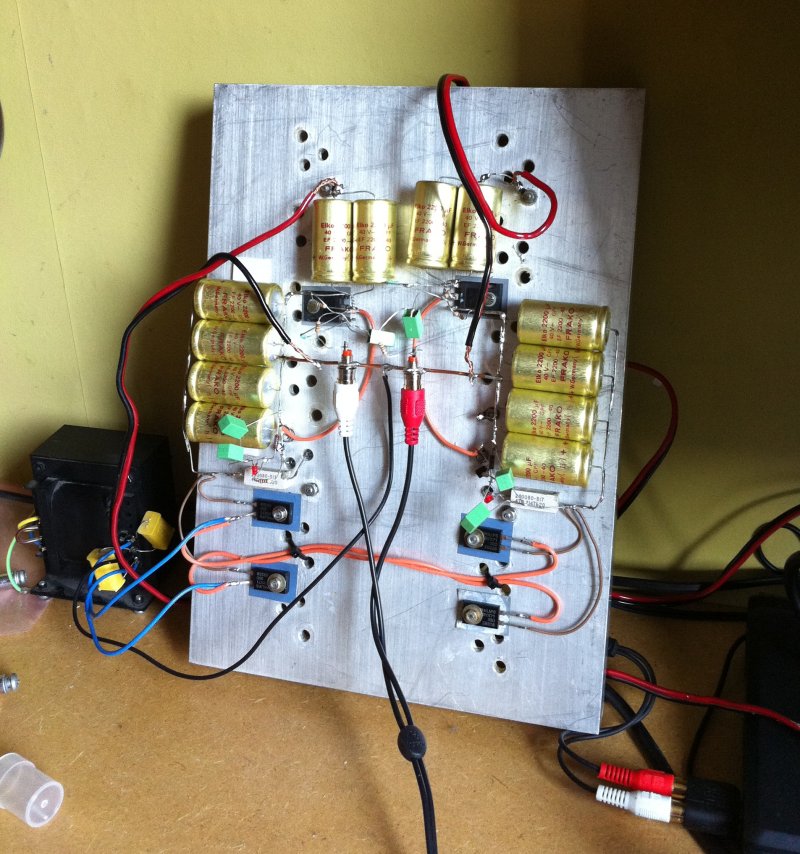
current source, set to 2A @ 15V, incredible how hot the heatsinks get after running for about an hour.
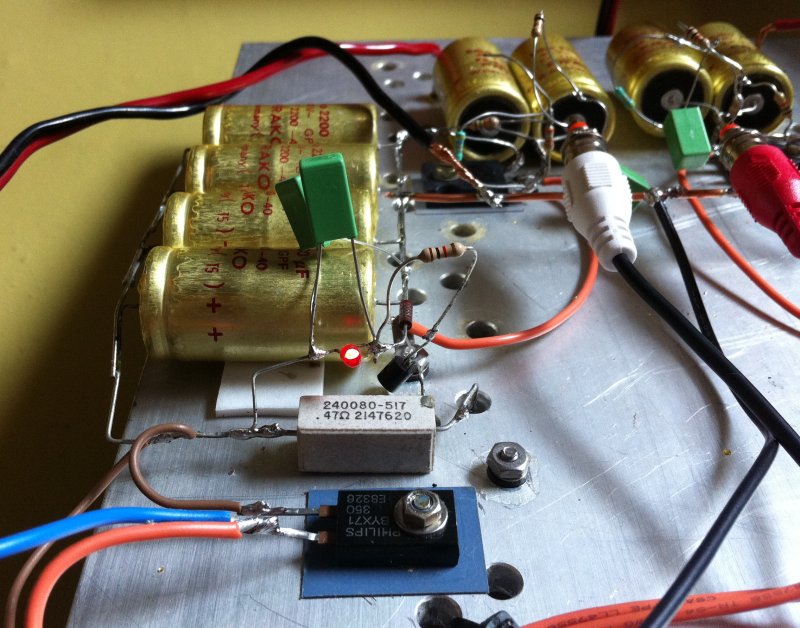
the good old IBM AS/400 IRFP440.
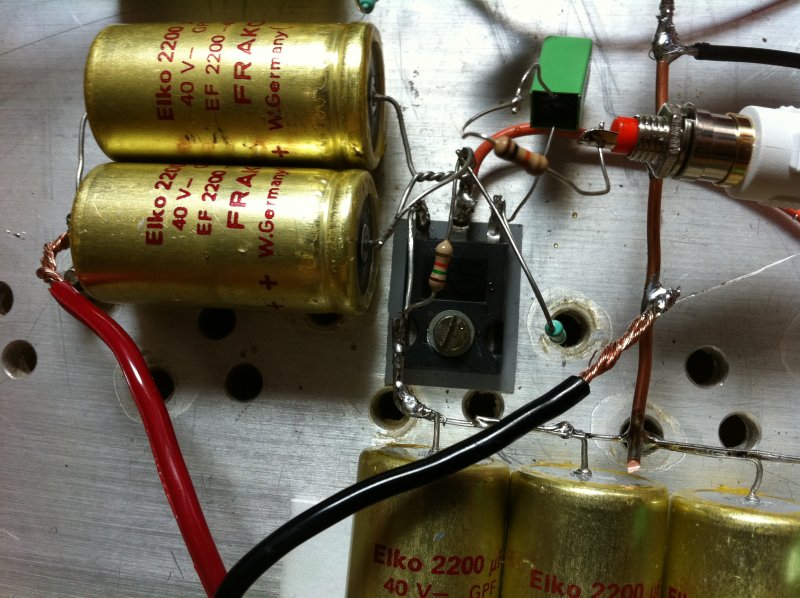
almost antique, the BD312 current source in an good old TO3 case
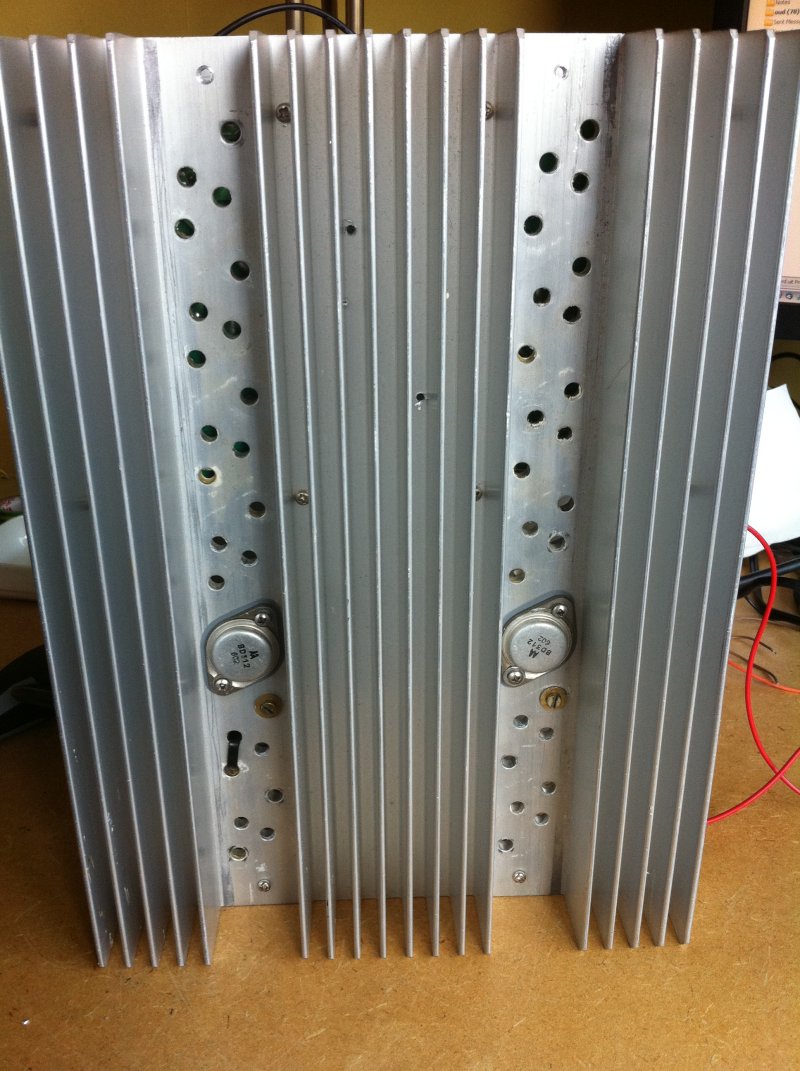
After enjoying the amp for a few hours I decided to spend some more time on it, the sound is really enjoyable ! Because the transformer was not really build to deliver in excess of 3A I had a stroll through my old psu scrapheap where I bumped into a pair of 65W 24V/2.5A switchers. Worth a try ! Because the smps normally get cooled by a fan I had to move the rectifiers of the pcb onto the heatsink because they we're running dangerously hot.
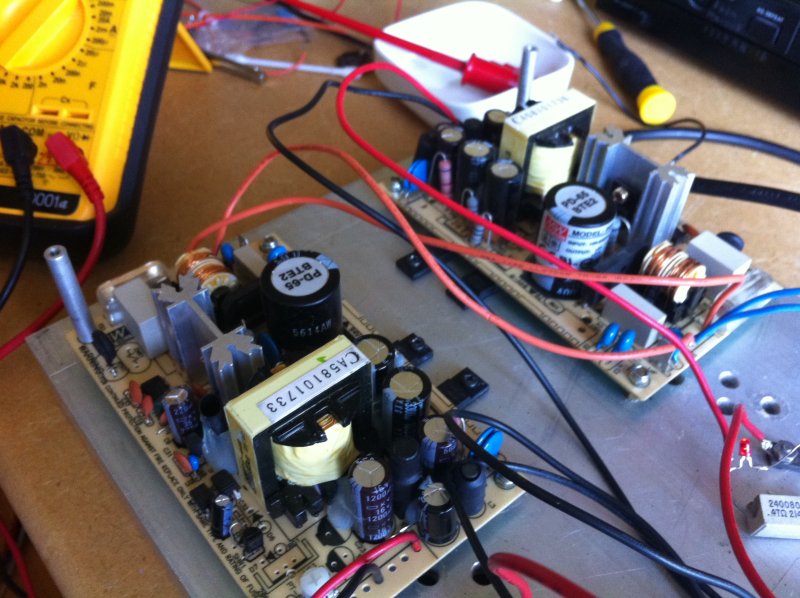
I've put the current source and switchers on one heatsink and the gainstages on the other.
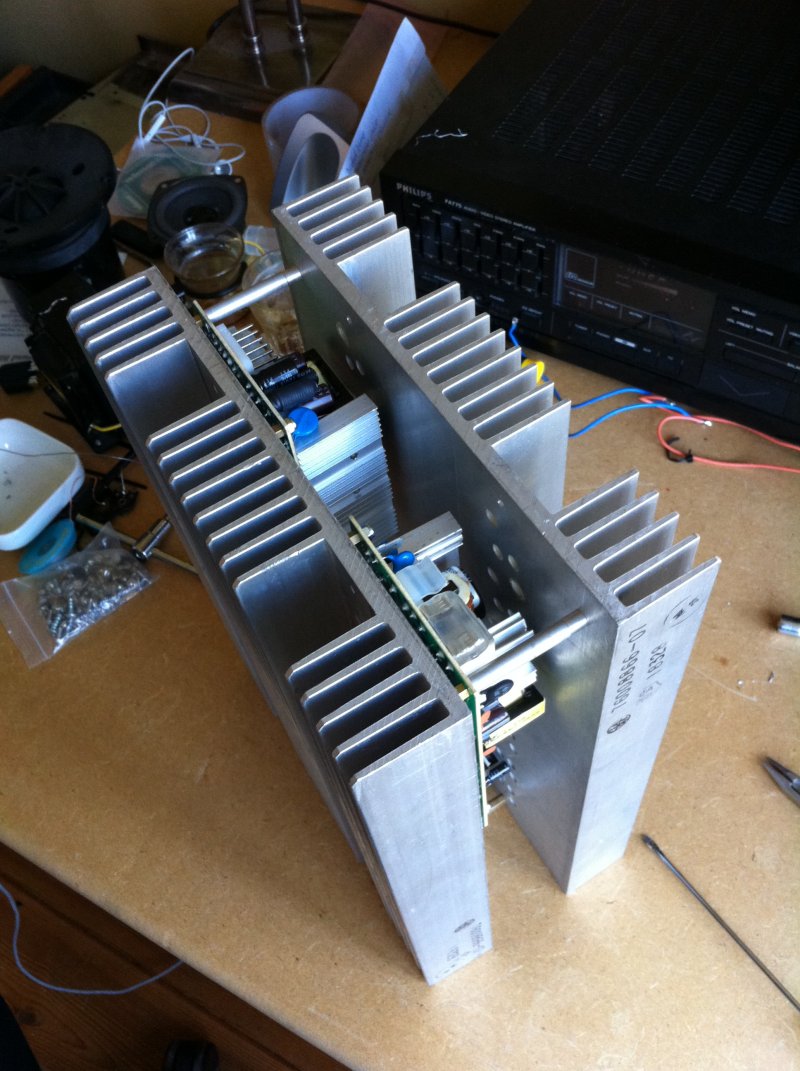
Neat huh ? the funny thing is that the switchers run pretty fine without the frako buffers caps, the total cap size is just 470uF ! I have tested running with and without 8800uF worth of frako's but couldn't tell the difference. (Hmm, this could well indeed be a sign that my ears have gone bad ). Whereas the old analog transformer did exhibit some 50hz hum these ones are dead silent.
). Whereas the old analog transformer did exhibit some 50hz hum these ones are dead silent.
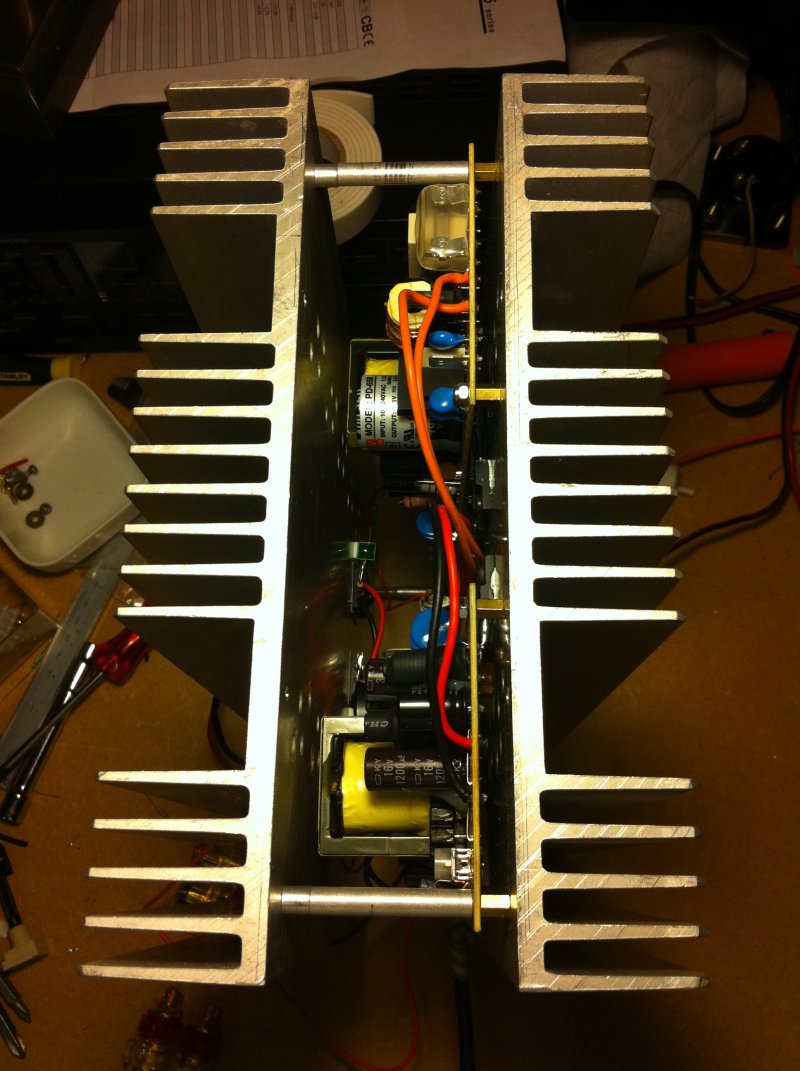
more pics tomorrow, it's 23:52 already ....
I'm quite happy with my dynaco stereo 70 but wanted to see how far this recycling thing would take me.

current source, set to 2A @ 15V, incredible how hot the heatsinks get after running for about an hour.

the good old IBM AS/400 IRFP440.

almost antique, the BD312 current source in an good old TO3 case

After enjoying the amp for a few hours I decided to spend some more time on it, the sound is really enjoyable ! Because the transformer was not really build to deliver in excess of 3A I had a stroll through my old psu scrapheap where I bumped into a pair of 65W 24V/2.5A switchers. Worth a try ! Because the smps normally get cooled by a fan I had to move the rectifiers of the pcb onto the heatsink because they we're running dangerously hot.

I've put the current source and switchers on one heatsink and the gainstages on the other.

Neat huh ? the funny thing is that the switchers run pretty fine without the frako buffers caps, the total cap size is just 470uF ! I have tested running with and without 8800uF worth of frako's but couldn't tell the difference. (Hmm, this could well indeed be a sign that my ears have gone bad

more pics tomorrow, it's 23:52 already ....
Last edited:
This is interesting, and I have wondered. Don't those type switchers run in the 40+KHz region? I wouldn't think you could hear them unless there was a multitude of lower frequency harmonics (cheap psu) or other switch mode related trash, but I'll bet you could still see something (perhaps inaudible) on a scope... But really - if you can't hear it - it must not be there. Especially if the hearing-aid batteries have run down.
- Home
- Amplifiers
- Pass Labs
- Pictures of your diy Pass amplifier